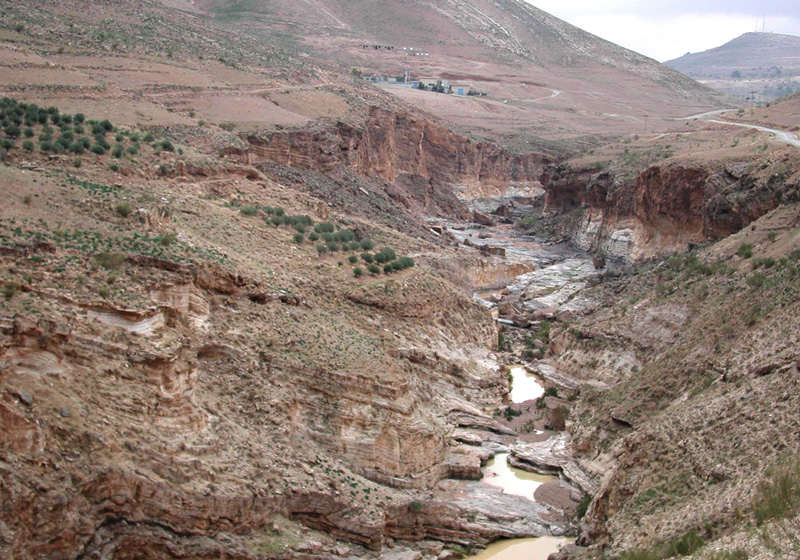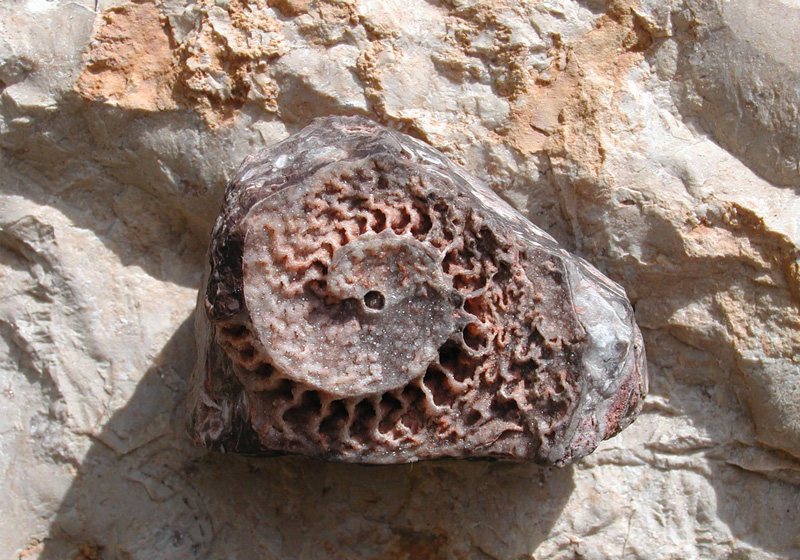Calamari in Stone
Wadi Wala, also called Heedan, can be visited in combination with Makawir at Jabal Bani Hamida, towards the end of the valley drive, and to avoid coming back the same way, you can drive up on the northern slopes to reach the road to Makawir at the village of Grayyat.

The Kings’ Highway on the wheat-land plateau south of Madaba reveals on its sides the uppermost layer of rock, the newest of a long stack of rocks. Beneath are layers upon layers of about a thousand meters of sedimentary rocks. From this kilometer of rocks that formed under water for the past 500 million years Wadi Wala brings you down to a cross-section in the upper rock layers of the last 144 million years. Driving down this wadi is like diving into the remote past. Each meter you descend brings you back 2000 centuries in time. You are driving in the past, in the pages of a giant book, each page or rock layer has kept in it the animals of its age; fossilized in stone. Like the way some preserve flowers between pages of a book, rock layers hold fossils of different kinds.
The upper rocks by the Kings’ Highway, are basically of limestone with chert stripes. This layer which geologists call “Um Rijam Chert-limestone" and the layer immediately below it “Mowaqqar Chalk Marl” are 160 meters in thick and basically poor in fossils. You have to drive –dive- further down, descending some 300 meters where rock layers become excitingly fossiliferous. Here look for grayish layers that are made of phosphate, that usually looks like concrete mixed with fine aggregate containing many tiny white spots that are the remains of tumbled bone fragments. This layer has fossils of sea animals such as oysters, gastropods, and fish teeth.

For the layer of ammonites drive further down, cross the bridge at the bottom and drive up again on the northern side of the valley. Look for a sandy layer in dark ochre turning at times into brick-red. In this layer “Fuhais limestone” and the layer below it "Na’ur limestone" ammonite shells are fossilized in big quantities. You have to imagine that you are walking on seashores, 144 to 66 million years old, where these animals once lived a flourishing life.
Ammonite shells are coiled-up from an inner smaller circle and outward into a bigger radius. The coil is basically the accumulations of growth; a spiral line of chambers separated by intricately lace-like lines called septa or sutures. The animal, which looked like a squid, was living in the last and biggest chamber. The rest of the older abandoned chambers were used for balance, to float or sink, just like air chambers in a submarine.
After living for hundreds of millions of years ammonites became extinct with the dinosaurs some 65 million years ago. The closest living shelly sea-animal is the Nautilus with its ornate shell. Ammonites were smart predators that fed on small fish. They were fast moving, using water-jet to maneuver and a hard well-engineered shell to hide in, when attacked by bigger predators. Size must have played some role in the survival game, and as a result, some ammonites grew up to 3 meters across. In Jordan the largest ammonite would usually be some 60cm in diameter.
Jordan is a geological paradise. Its geology and paleontology needs to be explained to the wider public, interpreted and protected. Jordan should have legislation in place to make sure that fossils, geological specimens as well as many wider landscape features, an important part of the country's natural heritage, are safely conserved.
The scope of tourism has the potential to be greatly enriched, to cover the much older and richer story of natural history, and not only depend on archaeology. "Geology tourism" is promising but could become destructive if not properly planned.
One-hour drive from Amman. Wadi Wala has its audience who return to it for the amazing variety of wild flowers and beautiful scenery. From Madaba, drive on the King's Highway for about 18 km, past the town of Libb till the road descends into a deep valley with a bridge. Immediately after the bridge exit to the right - westward, passing through a nursery, the road follows the valley on its southern side.